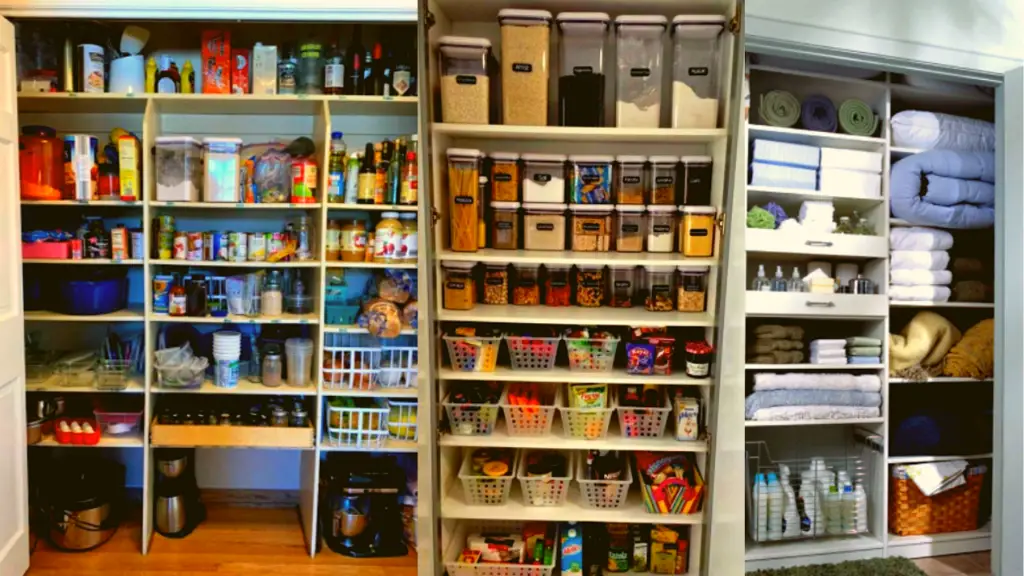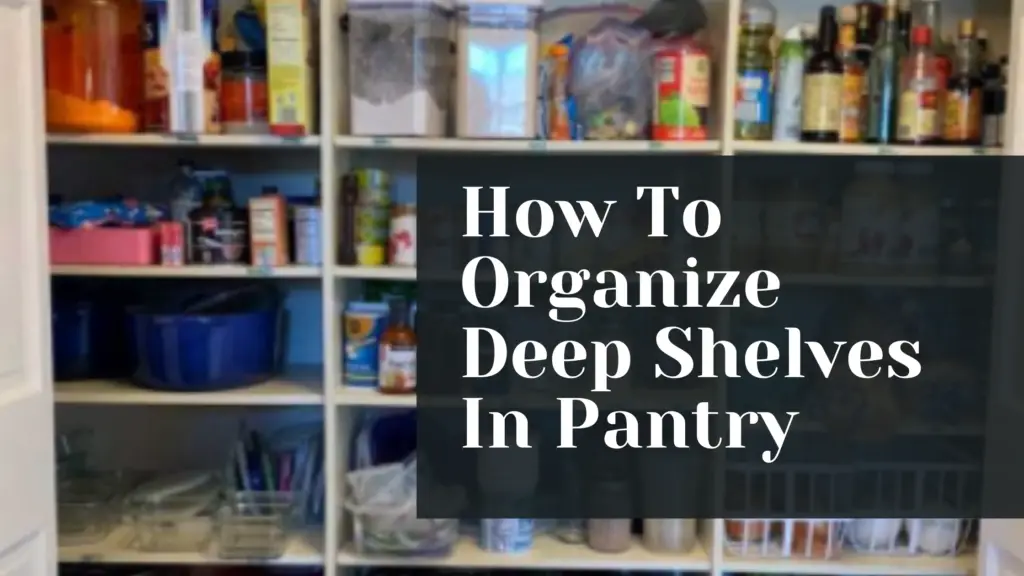
Due to the continual turnover of merchandise and including children’s food treats of all kinds. A deep pantry may be an asset for food, but it can also be a drawback since food can quickly go misplaced and expire. That’s why deep-pantry-organization skills are essential.
An untidy pantry may result in a lot of wasted food and frustration when you’re searching for an ingredient only to discover that you’ve run out. If you’ve ever struggled to find anything in your kitchen’s deep pantry, it may be time to reorganize. I have put together a complete guide on organizing deep shelves in the pantry.
- Recognize and classify what you have
- Designate areas in your pantry for specific purposes.
- Organize your most used goods to be in front
- Keep items out of children reach
- Put new goods towards the back of the closet.
- Organize items according to size.
- Invest in coordinating boxes and baskets.
- Use transparent containers to store Baking items.
- Clearly label everything.
- To maximize space, install shelves on the entrance.
- Add drawers to deep shelves.
- In the corner, place a turntable (rotating tray).
- Create a backstock section.
Whether you have a walk-in pantry or simply a closet or cabinet, here are some pointers to help make use of available storage space! First, when you have a lot of food in your pantry, it’s a good idea to organize it. To ensure you have enough storage space for the pantry’s usual supplies, you should begin this process as soon as your pantry seems depleted rather than wait until it is overflowing.
Organizing the Pantry Drawer is the First Step
De-cluttering is always the first step. For example, you may not think of food as “clutter,” but it can be in your cupboard! Would you please get rid of everything that has gone bad in your pantry? Take everything out of your pantry and toss away anything that has gone bad—surprising it’s how many minor items have flown past their expiration dates if you don’t keep an eye on your deep cupboard.
A perfect moment to take stock of your possessions is now, check if your deep pantry contains anything you’ve overlooked? Has anybody been eating anything that no one else has? Then, stop purchasing it by making a note of it.
Finally, ensure to wash off the shelves before placing food back in the pantry. As a result, pantry shelves are rarely cleaned to their maximum potential because it’s always crammed with cans and boxes of food. I hope these hints will make it simpler to organize your deep pantry once decluttered and cleaned.
How To Organize Deep Shelves In Pantry

Recognize and classify what you have
Place everything on your counters or kitchen table and sort everything according to kind and divided into broad groups. Then, it’s only a matter of grouping any comparable items.
Designate areas in your pantry for specific purposes.
When you’re organizing, having a well-stocked pantry is essential. First, you need to know how many items you typically own daily for each category. For example, you will need a more expansive area if you have a lot of can food on hand. Alternatively, if you usually stock up on kids’ treats and granola bars, you’ll want to create a dedicated area for snacking.
In the future, it will be easier to locate items if you have designated distinct zones for each category. So, in addition to knowing where to find the can of beans or bag of rice, you’ll also keep track of when certain items are running low. When arranging a deep pantry, creating zones is vital, so you don’t end up throwing away food.
Organize your most used goods to be in front
Which of your pantry’s contents is regularly consumed by your family? Finally, you may store it in the pantry’s most convenient location. For walk-in pantries, put the area where you can reach in and get things right next to the entrance. For a deep pantry, choose a shelf in a cabinet or closet that you can readily access.
Keep items out of children’s reach
If you have small children, put snacks out of their reach. Unfortunately, this is a lesson that most parents have to learn the hard way. Kids go into the pantry and take goodies without permission. If there are any items that you don’t want your children to eat, place them out of reach. Place items they can reach on their own lower down on the shelf, so you don’t have to assist them achieve them.
Put new goods towards the back of the closet.
When you go to the shop and purchase items, place them behind. As obvious as it may seem to you, it’s all too easy when you’re attempting to put away your groceries to throw your new food on the front shelf. Instead, pull forward what you currently have and place recently bought goods in the rear, even if it takes a few more seconds. Thanks to this, your food won’t go bad or be forgotten at the back of the cupboard.
Organize items according to size.
If you’re wondering what to store towards the back of your deep shelves, consider grouping items by size. Then, stack them on top of smaller containers or cartons. That way, you don’t have to shift anything about to see what’s on the shelf. Even if you’re using a basket system, this guideline still applies. Each category may be organized by size the same way you would if you were using bins or baskets.
Invest in coordinating boxes and baskets.
It’s a simple way to make a pantry seem more organized and clean. A deep pantry may benefit significantly from using bins and baskets, as they enable you to divide up your pantry into several parts, preventing goods from being buried. You can do this in two ways:
- Plan and figure out what zones and categories you want before organizing, giving you enough time to purchase baskets. You can buy a lot of various sizes and see what works as you go along.
- Finally, dispose of those no longer needed, or save them for future projects.
Some DIY bins and baskets are an option if you don’t want to spend money on a set. Use contact paper to cover the bottom half of containers to manage loose spice packets or fruit snacks. The size of the boxes you find will determine whether or not this method will work for more significant goods, but it’s excellent for organizing small items.
Use transparent containers to store Baking items.
This will go a long way toward improving your pantry. Put away the bags that come with your baking goods by storing them in transparent containers. To open and shut the bags, flour and sugar stream everywhere, and it’s almost hard to stack them. You should invest in large, transparent storage containers for a well-ordered and efficient pantry.
Plus, you’ll be able to tell exactly when you’re running out on any of your baking goods. If you have a lot of counter space, you can even do this with spaghetti, cereal, and oats.
Clearly label everything.
When it comes to organizing, labeling is one of the most delicate things you can do; it will not only make it simpler for you to find what you need when cooking, it will enable you to keep your pantry tidy. Also, calling for help from family to help unload the groceries will allow them to see where everything goes to put things away correctly.
To maximize space, install shelves on the entrance.
I’m a big fan of maximizing every inch of space in your home, and the back of the door is no exception. Consider purchasing door-mounted shelves or baskets if you have a small pantry. You may use them to store baking ingredients, spices, and even cans and jars.
Add drawers to deep shelves.
Having drawers on shelves is a good idea; simply sliding out the drawer and having access to everything is so much simpler with drawers than with shelves and other storage options that need shifting things about frequently to get to what’s behind it. I strongly suggest that it also save space on your shelves by taking advantage of the vertical area (like a set of wire or basket drawers) in your pantry.
In the corner, place a turntable (rotating tray).
Having a modest amount of turntable (rotating tray) is a lifesaver for those hard-to-reach places and high shelves. To get to the rear of the shelf, you won’t have to remove much clutter. For deep pantry organizations, they are beneficial. All you need is to provide enough room to turn it around rapidly. Then, you may use it to keep your pantry in order and efficient.
Create a backstock section.
A good option for those who have a hard time getting to a high shelf. Stock up on extras and use them when you need them. In addition, you can store items on sale for later use on the backstock section in a pantry; it helps you keep track of everything.
Conclusion
While designing and arranging your pantry, it’s crucial to remember that the system ought to be easy to maintain. The next time you return home with groceries, you don’t want to spend hours cleaning, clearing, and organizing. So make sure that your system works for you and be honest with yourself, especially on what you use regularly and most often.
